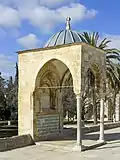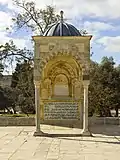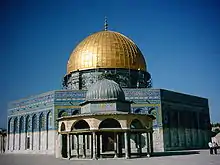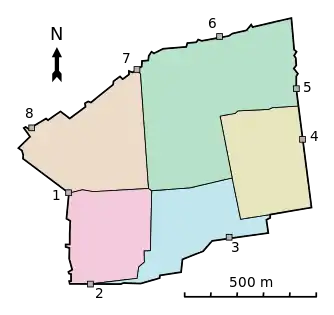Dome of Yusuf
The Dome of Yusuf (Qubbat Yusuf) is a free-standing domed-structure on the Temple Mount, located at the southern end of the Dome of the Rock terrace. It was built by Saladin in the late 12th century, and has been renovated several times.[1][2][3] It bears inscriptions from the 12th and 17th centuries: one dated 1191 in Saladin's name, and another to 1681 from Yusuf Agha, thought to have been the Governor of Jerusalem or a eunuch in the Ottoman imperial palace.[1][4][5]


A rectangular semi-enclosed structure, the Dome of Yusuf sits upon a solid stone wall and is supported by three pointed open arches. On the northern face of the southern wall, there are stone carvings and a marble-faced blind-niche. The exterior of the dome is covered in lead sheeting and the interior is decorated with a ribbed pattern.[4][5]
References
- Carole Hillenbrand (2000). The Crusades: Islamic perspectives (Illustrated, reprint, annotated ed.). Routledge. p. 191. ISBN 978-0-415-92914-1.
- Necipoğlu, Gülru (1998). Muqarnas: An Annual on the Visual Culture of the Islamic World (Illustrated, annotated ed.). BRILL. p. 73. ISBN 978-90-04-11084-7.
- Myriam Rosen-Ayalon (2006). Islamic art and archaeology in Palestine (Illustrated ed.). Left Coast Press. p. 97. ISBN 978-1-59874-064-6.
- Qubbat Yusuf Archived August 5, 2011, at the Wayback Machine Archnet Digital Library.
- Al-Aqsa Guide Friends of al-Aqsa 2007. Archived October 6, 2008, at the Wayback Machine

